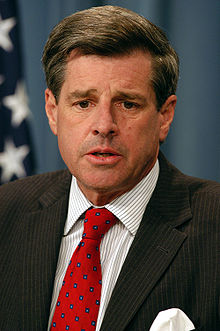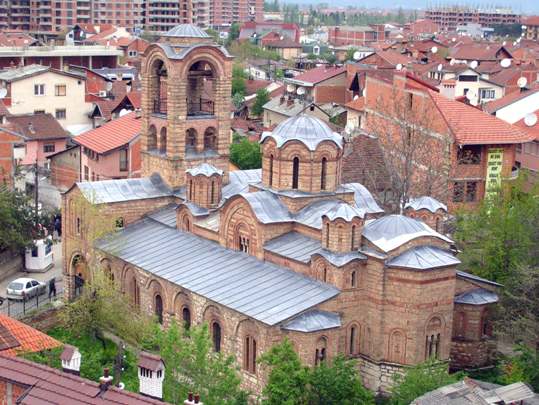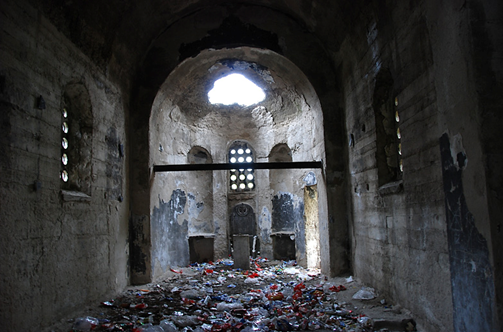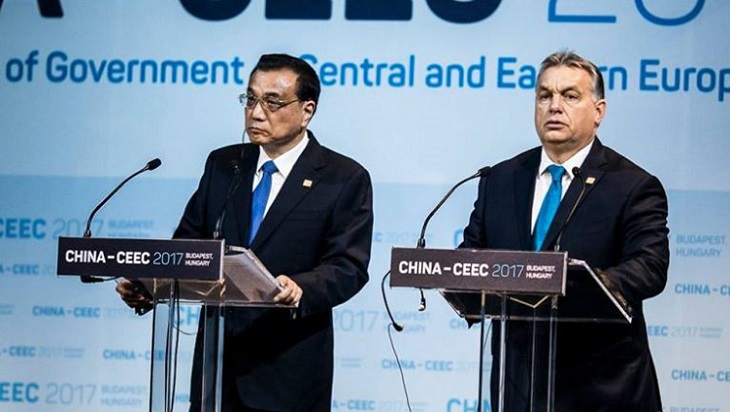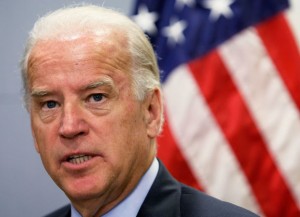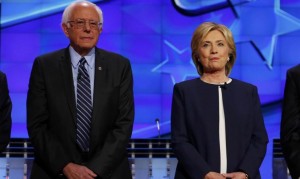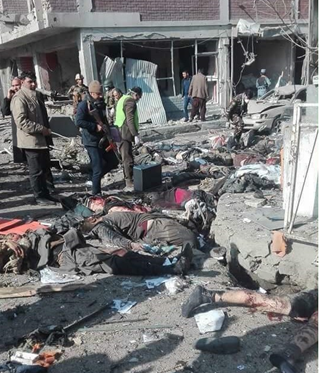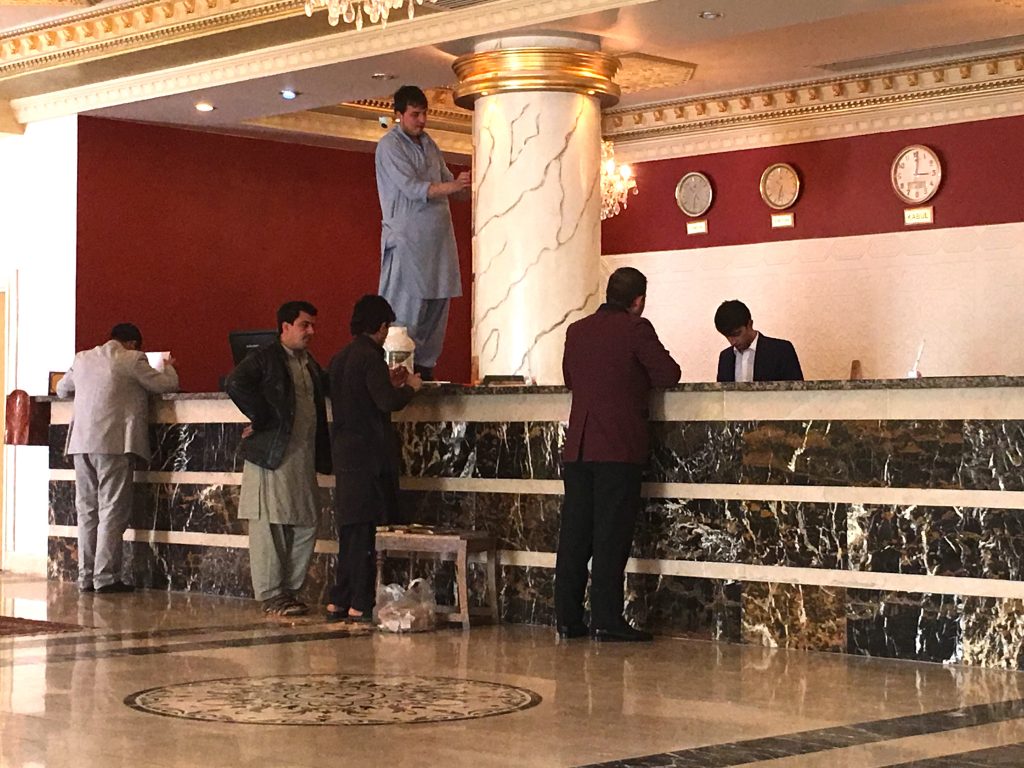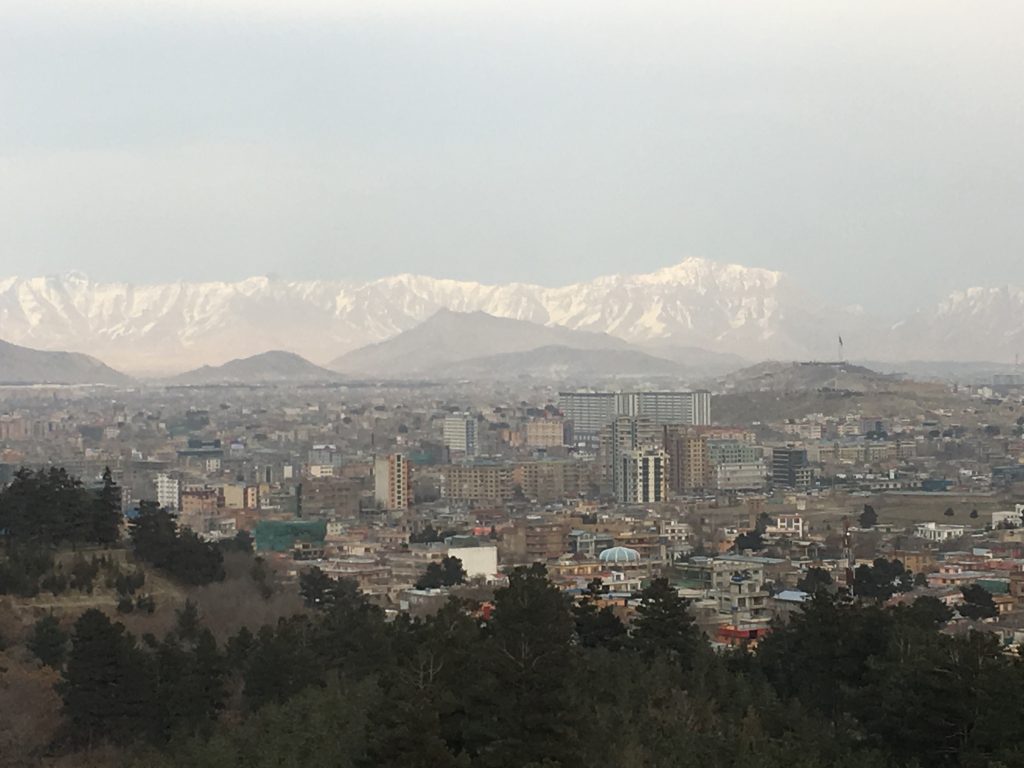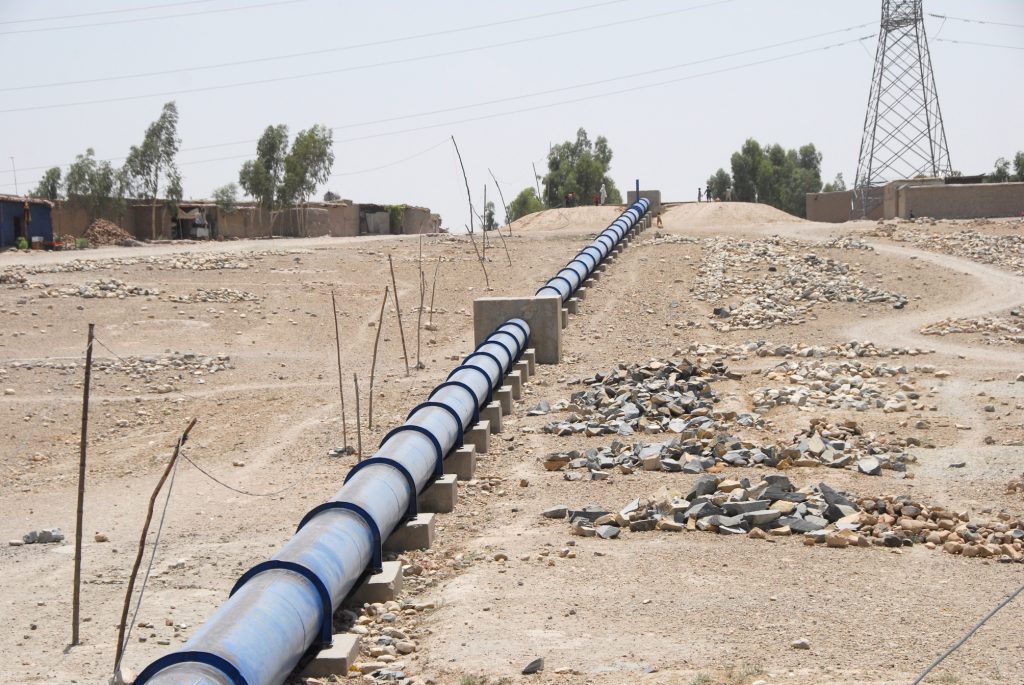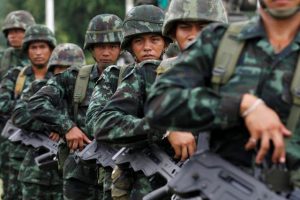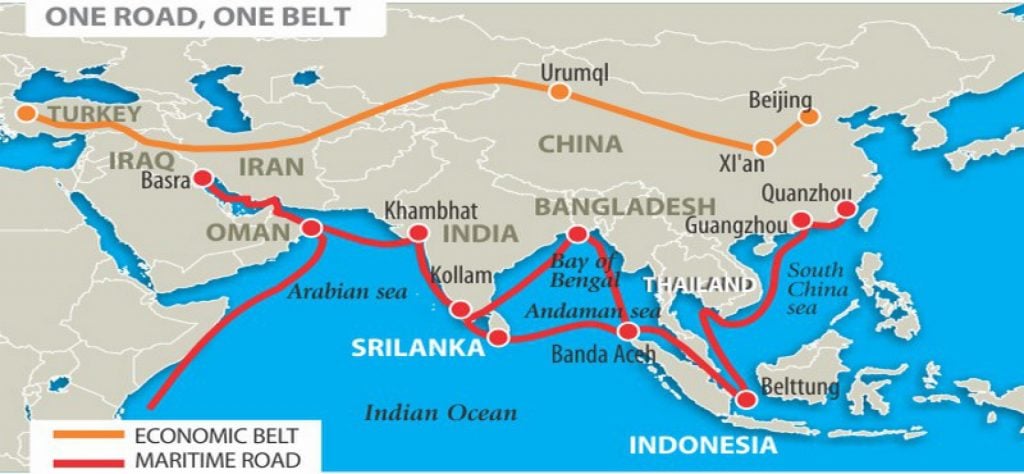Featured image: Robert Parry, 1949-2018
Robert Parry, editor and publisher of Consortiumnews.com, passed away on January 27th.
The Global Research team pays tribute to Robert Parry and his unwavering commitment to independent and honest journalism. His legacy will live.
Robert Parry was a powerful voice, incisive in his analysis of complex foreign policy issues, with a longstanding commitment to peace and social justice.
On January 1st, I sent a short New Year’s message to Robert Parry. Today our thoughts are with Robert Parry and his family.
To consult The Robert Parry Archive of articles posted on GR, click here.
In the following text, his son Nat Parry shares his thoughts on Robert Parry and his legacy.
Robert Parry’s Legacy is Truth in Media!
At this juncture in our history during which independent media is threatened, Robert Parry lives in our hearts and minds.
Michel Chossudovsky, January 29, 2018
***
It is with a heavy heart that we inform Consortiumnews readers that Editor Robert Parry has passed away. As regular readers know, Robert (or Bob, as he was known to friends and family) suffered a stroke in December, which – despite his own speculation that it may have been brought on by the stress of covering Washington politics – was the result of undiagnosed pancreatic cancer that he had been unknowingly living with for the past 4-5 years.
He unfortunately suffered two more debilitating strokes in recent weeks and after the last one, was moved to hospice care on Tuesday. He passed away peacefully Saturday evening. He was 68.
Those of us close to him wish to sincerely thank readers for the kind comments and words of support posted on recent articles regarding Bob’s health issues. We read aloud many of these comments to him during his final days to let him know how much his work has meant to so many people and how much concern there was for his well-being.
I am sure that these kindnesses meant a lot to him. They also mean a lot to us as family members, as we all know how devoted he was to the mission of independent journalism and this website which has been publishing articles since the earliest days of the internet, launching all the way back in 1995.
With my dad, professional work has always been deeply personal, and his career as a journalist was thoroughly intertwined with his family life. I can recall kitchen table conversations in my early childhood that focused on the U.S.-backed wars in Central America and complaints about how his editors at The Associated Press were too timid to run articles of his that – no matter how well-documented – cast the Reagan administration in a bad light.
One of my earliest memories in fact was of my dad about to leave on assignment in the early 1980s to the war zones of El Salvador, Nicaragua and Guatemala, and the heartfelt good-bye that he wished to me and my siblings. He warned us that he was going to a very dangerous place and that there was a possibility that he might not come back.
I remember asking him why he had to go, why he couldn’t just stay at home with us. He replied that it was important to go to these places and tell the truth about what was happening there. He mentioned that children my age were being killed in these wars and that somebody had to tell their stories. I remember asking, “Kids like me?” He replied, “Yes, kids just like you.”
Bob was deeply impacted by the dirty wars of Central America in the 1980s and in many ways these conflicts – and the U.S. involvement in them – came to define the rest of his life and career. With grisly stories emerging from Nicaragua (thanks partly to journalists like him), Congress passed the Boland Amendments from 1982 to 1984, which placed limits on U.S. military assistance to the contras who were attempting to overthrow the Sandinista government through a variety of terrorist tactics.
The Reagan administration immediately began exploring ways to circumvent those legal restrictions, which led to a scheme to send secret arms shipments to the revolutionary and vehemently anti-American government of Iran and divert the profits to the contras. In 1985, Bob wrote the first stories describing this operation, which later became known as the Iran-Contra Affair.
Contra-Cocaine and October Surprise
Parallel to the illegal arms shipments to Iran during those days was a cocaine trafficking operation by the Nicaraguan contras and a willingness by the Reagan administration and the CIA to turn a blind eye to these activities. This, despite the fact that cocaine was flooding into the United States while Ronald Reagan was proclaiming a “war on drugs,” and a crack cocaine epidemic was devastating communities across the country.
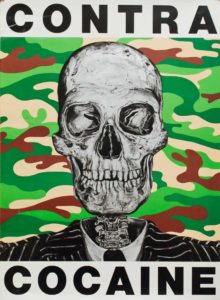
Poster by street artist and friend of Bob, Robbie Conal
Bob and his colleague Brian Barger were the first journalists to report on this story in late 1985, which became known as the contra-cocaine scandal and became the subject of a congressional investigation led by then-Senator John Kerry (D-Mass.) in 1986.
Continuing to pursue leads relating to Iran-Contra during a period in the late 80s when most of Washington was moving on from the scandal, Bob discovered that there was more to the story than commonly understood. He learned that the roots of the illegal arm shipments to Iran stretched back further than previously known – all the way back to the 1980 presidential campaign.
That electoral contest between incumbent Jimmy Carter and challenger Ronald Reagan had come to be largely dominated by the hostage crisis in Iran, with 52 Americans being held at the U.S. embassy in Tehran since the 1979 Iranian Revolution. The Iranian hostage crisis, along with the ailing economy, came to define a perception of an America in decline, with former Hollywood actor Ronald Reagan promising a new start for the country, a restoration of its status as a “shining city on a hill.”
The hostages were released in Tehran moments after Reagan was sworn in as president in Washington on January 20, 1981. Despite suspicions for years that there had been some sort of quid pro quo between the Reagan campaign and the Iranians, it wasn’t until Bob uncovered a trove of documents in a House office building basement in 1994 that the evidence became overwhelming that the Reagan campaign had interfered with the Carter administration’s efforts to free the hostages prior to the 1980 election. Their release sooner – what Carter hoped would be his “October Surprise” – could have given him the boost needed to win.
Examining these documents and being already well-versed on this story – having previously travelled three continents pursuing the investigation for a PBS Frontline documentary – Bob became increasingly convinced that the Reagan campaign had in fact sabotaged Carter’s hostage negotiations, possibly committing an act of treason in an effort to make sure that 52 American citizens continued to be held in a harrowing hostage situation until after Reagan secured the election.
Needless to say, this was an inconvenient story at a time – in the mid-1990s – when the national media had long since moved on from the Reagan scandals and were obsessing over new scandals, mostly related to President Bill Clinton’s sex life and failed real estate deals. Washington also wasn’t particularly interested in challenging the Reagan legacy, which at that time was beginning to solidify into a kind of mythology, with campaigns underway to name buildings and airports after the former president.
At times, Bob had doubts about his career decisions and the stories he was pursuing. As he wrote in Trick or Treason, a book outlining his investigation into the October Surprise Mystery, this search for historical truth can be painful and seemingly thankless.
“Many times,” he wrote, “I had regretted accepting Frontline’s assignment in 1990. I faulted myself for risking my future in mainstream journalism. After all, that is where the decent-paying jobs are. I had jeopardized my ability to support my four children out of an old-fashioned sense of duty, a regard for an unwritten code that expects reporters to take almost any assignment.”
Nevertheless, Bob continued his efforts to tell the full story behind both the Iran-Contra scandal and the origins of the Reagan-Bush era, ultimately leading to two things: him being pushed out of the mainstream media, and the launching of Consortiumnews.com.
I remember when he started the website, together with my older brother Sam, back in 1995. At the time, in spite of talk we were all hearing about something called “the information superhighway” and “electronic mail,” I had never visited a website and didn’t even know how to get “on line.” My dad called me in Richmond, where I was a sophomore at Virginia Commonwealth University, and told me I should check out this new “Internet site” he and Sam had just launched.
He explained over the phone how to open a browser and instructed me how to type in the URL, starting, he said, with “http,” then a colon and two forward slashes, then “www,” then “dot,” then this long address with one or two more forward slashes if I recall. (It wasn’t until years later that the website got its own domain and a simpler address.)
I went to the computer lab at the university and asked for some assistance on how to get online, dutifully typed in the URL, and opened this website – the first one I had ever visited. It was interesting, but a bit hard to read on the computer screen, so I printed out some articles to read back in my dorm room.
I quickly became a fan of “The Consortium,” as it was called back then, and continued reading articles on the October Surprise Mystery as Bob and Sam posted them on this new and exciting tool called “the Internet.” Sam had to learn HTML coding from scratch to launch this online news service, billed as “the Internet’s First Investigative ‘Zine.” For his efforts, Sam was honored with the Consortium for Independent Journalism’s first Gary Webb Freedom of the Press Award in 2015.
X-Files and Contra-Crack
At some point along the way, Bob decided that in addition to the website, where he was not only posting original articles but also providing the source documents that he had uncovered in the House office building basement, he would also take a stab at traditional publishing. He compiled the “October Surprise X-Files” into a booklet and self-published it in January 1996.
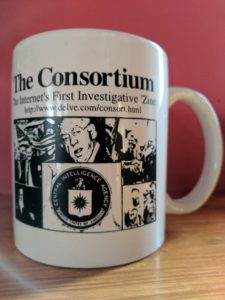
Original Consortium merchandise from 1996.
He was also publishing a newsletter to complement the website, knowing that at that time, there were still plenty of people who didn’t know how to turn a computer on, much less navigate the World Wide Web. I transferred from Virginia Commonwealth University to George Mason University in the DC suburbs and started working part-time with my dad and Sam on the newsletter and website.
We worked together on the content, editing and laying it out with graphics often culled from books at our local library. We built a subscriber base through networking and purchasing mailing lists from progressive magazines. Every two weeks we would get a thousand copies printed from Sir Speedy and would spend Friday evening collating these newsletters and sending them out to our subscribers.
The launching of the website and newsletter, and later an even-more ambitious project called I.F. Magazine, happened to coincide with the publication in 1996 of Gary Webb’s “Dark Alliance” series at the San Jose Mercury-News. Webb’s series reopened the contra-cocaine controversy with a detailed examination of the drug trafficking networks in Nicaragua and Los Angeles that had helped to spread highly addictive crack cocaine across the United States.
The African-American community, in particular, was rightly outraged over this story, which offered confirmation of many long-standing suspicions that the government was complicit in the drug trade devastating their communities. African Americans had been deeply and disproportionately affected by the crack epidemic, both in terms of the direct impact of the drug and the draconian drug laws and mandatory minimum sentences that came to define the government’s approach to “the war on drugs.”
For a moment in the summer of 1996, it appeared that the renewed interest in the contra-cocaine story might offer an opportunity to revisit the crimes and misdeeds of the Reagan-Bush era, but those hopes were dashed when the “the Big Media” decided to double down on its earlier failures to cover this story properly.
Big Papers Pile On
The Los Angeles Times launched the attack on Gary Webb and his reporting at the San Jose Mercury-News, followed by equally dismissive stories at the Washington Post and New York Times. The piling on from these newspapers eventually led Mercury-News editor Jerry Ceppos to denounce Webb’s reporting and offer a mea culpa for publishing the articles.
The onslaught of hostile reporting from the big papers failed to address the basic premises of Webb’s series and did not debunk the underlying allegations of contra-cocaine smuggling or the fact that much of this cocaine ended up on American streets in the form of crack. Instead, it raised doubts by poking holes in certain details and casting the story as a “conspiracy theory.” Some of the reporting attempted to debunk claims that Webb never actually made – such as the idea that the contra-cocaine trafficking was part of a government plot to intentionally decimate the African-American community.
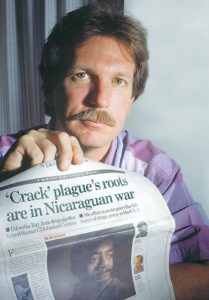
Gary Webb holds up a copy of the San Jose Mercury-News with his front-page story.
Gary Webb and Bob were in close contact during those days. Bob offered him professional and personal support, having spent his time also on the receiving end of attacks by journalistic colleagues and editors who rejected certain stories – no matter how factual – as fanciful conspiracy theories. Articles at The Consortium website and newsletter, as well as I.F. Magazine, offered details on the historical context for the “Dark Alliance” series and pushed back against the mainstream media’s onslaught of hostile and disingenuous reporting.
Bob also published the book Lost History which provided extensive details on the background for the “Dark Alliance” series, explaining that far from a baseless “conspiracy theory,” the facts and evidence strongly supported the conclusion that the Reagan-Bush administrations had colluded with drug traffickers to fund their illegal war against Nicaragua.
But sadly, the damage to Gary Webb was done. With his professional and personal life in tatters because of his courageous reporting on the contra-cocaine story, he committed suicide in 2004 at the age of 49. Speaking about this suicide later on Democracy Now, Bob noted how painful it is to be ridiculed and unfairly criticized by colleagues, as his friend had experienced.
“There’s a special pain when your colleagues in your profession turn on you, especially when you’ve done something that they should admire and should understand,” he said. “To do all that work and then have the New York Times and the Washington Post and the Los Angeles Times attack you and try to destroy your life, there’s a special pain in that.”
In consultation with his family, Bob and the Board of Directors for the Consortium for Independent Journalism launched the Gary Webb Freedom of the Press Award in 2015.
The Disastrous Presidency of George W. Bush
The presidency of George W. Bush was surreal for many of us, and no one more so than my dad.
In covering Washington politics for decades, Bob had traced many stories to “Dubya’s” father, George H.W. Bush, who had been implicated in a variety of questionable activities, including the October Surprise Mystery and Iran-Contra. He had also launched a war against Iraq in 1991 that seemed to be motivated, at least in part, to help kick “the Vietnam Syndrome,” i.e. the reluctance that the American people had felt since the Vietnam War to support military action abroad.
As Bob noted in his 1992 book Fooling America, after U.S. forces routed the Iraqi military in 1991, President Bush’s first public comment about the victory expressed his delight that it would finally put to rest the American reflex against committing troops to far-off conflicts. “By God, we’ve kicked the Vietnam Syndrome once and for all,” he exulted.
The fact that Bush-41’s son could run for president largely on name recognition confirmed to Bob the failure of the mainstream media to cover important stories properly and the need to continue building an independent media infrastructure. This conviction solidified through Campaign 2000 and the election’s ultimate outcome, when Bush assumed the White House as the first popular-vote loser in more than a century.
Despite the fact that the U.S. Supreme Court had halted the counting of votes in Florida, thus preventing an accurate determination of the rightful winner, most of the national media moved on from the story after Bush was sworn in on Jan. 20, 2001. Consortiumnews.com continued to examine the documentary record, however, and ultimately concluded that Al Gore would have been declared the winner of that election if all the legally cast ballots were counted.
At Consortiumnews, there was an unwritten editorial policy that the title “President” should never precede George W. Bush’s name, based on our view that he was not legitimately elected. But beyond those editorial decisions, we also understood the gravity of the fact that had Election 2000 been allowed to play out with all votes counted, many of the disasters of the Bush years – notably the 9/11 tragedy and the Iraq War, as well as decisions to withdraw from international agreements on arms control and climate change – might have been averted.
As all of us who lived through the post-9/11 era will recall, it was a challenging time all around, especially if you were someone critical of George W. Bush. The atmosphere in that period did not allow for much dissent. Those who stood up against the juggernaut for war – such as Phil Donahue at MSNBC, Chris Hedges at the New York Times, or even the Dixie Chicks – had their careers damaged and found themselves on the receiving end of death threats and hate mail.
While Bob’s magazine and newsletter projects had been discontinued, the website was still publishing articles, providing a home for dissenting voices that questioned the case for invading Iraq in late 2002 and early 2003. Around this time, former CIA analyst Ray McGovern and some of his colleagues founded Veteran Intelligence Professionals for Sanity and a long-running relationship with Consortiumnews was established. Several former intelligence veterans began contributing to the website, motivated by the same independent spirit of truth-telling that compelled Bob to invest so much in this project.
At a time when almost the entire mainstream media was going along with the Bush administration’s dubious case for war, this and a few other like-minded websites pushed back with well-researched articles calling into question the rationale. Although at times it might have felt as though we were just voices in the wilderness, a major groundswell of opposition to war emerged in the country, with historic marches of hundreds of thousands taking place to reject Bush’s push for war.
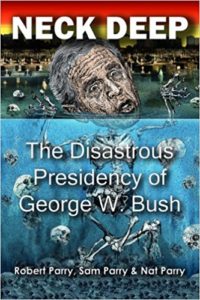
Neck Deep was published by the Media Consortium in 2007.
Of course, these antiwar voices were ultimately vindicated by the failure to find weapons of mass destruction in Iraq and the fact that the war and occupation proved to be a far costlier and deadlier enterprise than we had been told that it would be. Earlier assurances that it would be a “cakewalk” proved as false as the WMD claims, but as had been so often the case in Washington, there was little to no accountability from the mainstream media, the think tanks or government officials for being so spectacularly wrong.
In an effort to document the true history of that era, Bob, Sam and I co-wrote the book Neck Deep: The Disastrous Presidency of George W. Bush, which was published in late 2007. The book traced the work of Consortiumnews, juxtaposing it against the backdrop of mainstream media coverage during the Bush era, in an effort to not only correct the record, but also demonstrate that not all of us got things so wrong.
We felt it was important to remind readers – as well as future historians – that some of us knew and reported in real time the mistakes that were being made on everything from withdrawing from the Kyoto Protocol to invading Iraq to implementing a policy of torture to bungling the response to Hurricane Katrina.
Obama Era
By the time Barack Obama was elected the 44th president, Consortiumnews.com had become a home to a growing number of writers who brought new perspectives to the website’s content. While for years, the writing staff had been limited primarily to Bob, Sam and me, suddenly, Consortiumnews was receiving contributions from journalists, activists and former intelligence analysts who offered a wide range of expertise – on international law, economics, human rights, foreign policy, national security, and even religion and philosophy.
One recurring theme of articles at the website during the Obama era was the enduring effect of unchallenged narratives, how they shaped national politics and dictated government policy. Bob observed that even a supposedly left-of-center president like Obama seemed beholden to the false narratives and national mythologies dating back to the Reagan era. He pointed out that this could be at least partially attributed to the failure to establish a strong foundation for independent journalism.
In a 2010 piece called “Obama’s Fear of the Reagan Narrative,” Bob noted that Obama had defended his deal with Republicans on tax cuts for the rich because there was such a strong lingering effect of Reagan’s messaging from 30 years earlier. “He felt handcuffed by the Right’s ability to rally Americans on behalf of Reagan’s ‘government-is-the-problem’ message,” Bob wrote.
He traced Obama’s complaints about his powerlessness in the face of this dynamic to the reluctance of American progressives to invest sufficiently in media and think tanks, as conservatives had been doing for decades in waging their “the war of ideas.” As he had been arguing since the early 1990s, Robert insisted that the limits that had been placed on Obama – whether real or perceived – continued to demonstrate the power of propaganda and the need for greater investment in alternative media.
He also observed that much of the nuttiness surrounding the so-called Tea Party movement resulted from fundamental misunderstandings of American history and constitutional principles. “Democrats and progressives should be under no illusion about the new flood of know-nothingism that is about to inundate the United States in the guise of a return to ‘first principles’ and a deep respect for the U.S. Constitution,” Bob warned.
He pointed out that despite the Tea Partiers’ claimed reverence for the Constitution, they actually had very little understanding of the document, as revealed by their ahistorical claims that federal taxes are unconstitutional. In fact, as Bob observed, the Constitution represented “a major power grab by the federal government, when compared to the loosely drawn Articles of Confederation, which lacked federal taxing authority and other national powers.”
Motivated by a desire to correct falsified historical narratives spanning more than two centuries, Bob published his sixth and final book, America’s Stolen Narrative: From Washington and Madison to Nixon, Reagan and the Bushes to Obama, in 2012.
Along with revenues from book sales, growing donations from readers enabled Bob to not only pay writers but also to hire an assistant, Chelsea Gilmour, who began working for Consortiumnews in 2014. In addition to providing invaluable administrative support, Chelsea also performed duties including research, writing and fact-checking.
Political Realignment and the New McCarthyism
Although at the beginning of the Obama era – and indeed since the 1980s – the name Robert Parry had been closely associated with exposing wrongdoing by Republicans, and hence had a strong following among Democratic Party loyalists, by the end of Obama’s presidency there seemed to be a realignment taking place among some of Consortiumnews.com’s readership, which reflected more generally the shifting politics of the country.
In particular, the U.S. media’s approach to Russia and related issues, such as the violent ouster in 2014 of Ukrainian President Viktor Yanukovych, became “virtually 100 percent propaganda,” Bob said.
He noted that the full story was never told when it came to issues such as the Sergei Magnitsky case, which led to the first round of U.S. sanctions against Russia, nor the inconvenient facts related to the Euromaidan protests that led to Yanukovych’s ouster – including the reality of strong neo-Nazi influence in those protests – nor the subsequent conflict in the Donbass region of Ukraine.
Bob’s stories on Ukraine were widely cited and disseminated, and he became an important voice in presenting a fuller picture of the conflict than was possible by reading and watching only mainstream news outlets. Bob was featured prominently in Oliver Stone’s 2016 documentary “Ukraine on Fire,” where he explained how U.S.-funded political NGOs and media companies have worked with the CIA and foreign policy establishment since the 1980s to promote the U.S. geopolitical agenda.
Bob regretted that, increasingly, “the American people and the West in general are carefully shielded from hearing the ‘other side of the story.’” Indeed, he said that to even suggest that there might be another side to the story is enough to get someone branded as an apologist for Vladimir Putin or a “Kremlin stooge.”

The PropOrNot logo
This culminated in late 2016 in the blacklisting of Consortiumnews.com on a dubious website called “PropOrNot,” which was claiming to serve as a watchdog against undue “Russian influence” in the United States. The PropOrNot blacklist, including Consortiumnews and about 200 other websites deemed “Russian propaganda,” was elevated by the Washington Post as a credible source, despite the fact that the neo-McCarthyites who published the list hid behind a cloak of anonymity.
“The Post’s article by Craig Timberg,” Bob wrote on Nov. 27, 2016, “described PropOrNot simply as ‘a nonpartisan collection of researchers with foreign policy, military and technology backgrounds [who] planned to release its own findings Friday showing the startling reach and effectiveness of Russian propaganda campaigns.’”
As Bob explained in an article called “Washington Post’s Fake News Guilt,” the paper granted PropOrNot anonymity “to smear journalists who don’t march in lockstep with official pronouncements from the State Department or some other impeccable fount of never-to-be-questioned truth.”
The Post even provided an unattributed quote from the head of the shadowy website. “The way that this propaganda apparatus supported [Donald] Trump was equivalent to some massive amount of a media buy,” the anonymous smear merchant said. The Post claimed that the PropOrNot “executive director” had spoken on the condition of anonymity “to avoid being targeted by Russia’s legions of skilled hackers.”
To be clear, neither Consortiumnews nor Robert Parry ever “supported Trump,” as the above anonymous quote claims. Something interesting, however, did seem to be happening in terms of Consortiumnews’ readership in the early days of the Trump presidency, as could be gleaned from some of the comments left on articles and social media activity.
It did appear for some time at least that a good number of Trump supporters were reading Consortiumnews, which could probably be attributed to the fact that the website was one of the few outlets pushing back against both the “New Cold War” with Russia and the related story of “Russiagate,” which Bob didn’t even like referring to as a “scandal.” (As an editor, he preferred to use the word “controversy” on the website, because as far as he was concerned, the allegations against Trump and his supposed “collusion” with Russia did not rise to the level of actual scandals such as Watergate or Iran-Contra.)
In his view, the perhaps understandable hatred of Trump felt by many Americans – both inside and outside the Beltway – had led to an abandonment of old-fashioned rules of journalism and standards of fairness, which should be applied even to someone like Donald Trump.
“On a personal note, I faced harsh criticism even from friends of many years for refusing to enlist in the anti-Trump ‘Resistance,’” Bob wrote in his final article for Consortiumnews.
“The argument was that Trump was such a unique threat to America and the world that I should join in finding any justification for his ouster,” he said. “Some people saw my insistence on the same journalistic standards that I had always employed somehow a betrayal.”
He marveled that even senior editors in the mainstream media treated the unproven Russiagate allegations as flat fact.
“No skepticism was tolerated and mentioning the obvious bias among the never-Trumpers inside the FBI, Justice Department and intelligence community was decried as an attack on the integrity of the U.S. government’s institutions,” Bob wrote. “Anti-Trump ‘progressives’ were posturing as the true patriots because of their now unquestioning acceptance of the evidence-free proclamations of the U.S. intelligence and law enforcement agencies.”
An Untimely End and the Future of Consortiumnews
My dad’s untimely passing has come as a shock to us all, especially since up until a month ago, there was no indication whatsoever that he was sick in any way. He took good care of himself, never smoked, got regular check-ups, exercised, and ate well. The unexpected health issues starting with a mild stroke Christmas Eve and culminating with his admission into hospice care several days ago offer a stark reminder that nothing should be taken for granted.
And as many Consortiumnews readers have eloquently pointed out in comments left on recent articles regarding Bob’s health, it also reminds us that his brand of journalism is needed today more than ever.
“We need free will thinkers like you who value the truth based on the evidence and look past the group think in Washington to report on the real reasons for our government’s and our media’s actions which attempt to deceive us all,” wrote, for example, “FreeThinker.”
“Common sense and integrity are the hallmarks of Robert Parry’s journalism. May you get better soon for you are needed more now then ever before,” wrote “T.J.”
“We need a new generation of reporters, journalists, writers, and someone always being tenacious to follow up on the story,” added “Tina.”
As someone who has been involved with this website since its inception – as a writer, an editor and a reader – I concur with these sentiments. Readers should rest assured that despite my dad’s death, every effort will be made to ensure that the website will continue going strong.
Indeed, I think that everyone involved with this project wants to uphold the same commitment to truth-telling without fear or favor that inspired Bob and his heroes like George Seldes, I.F. Stone, and Thomas Paine.
That commitment can be seen in my dad’s pursuit of stories such as those mentioned above, but also so many others – including his investigations into the financial relationship of the influential Washington Times with the Unification Church cult of Rev. Sun Myung Moon, the truth behind the Nixon campaign’s alleged efforts to sabotage President Lyndon Johnson’s Paris peace talks with Vietnamese leaders in 1968, the reality of the chemical attack in Syria in 2013, and even detailed examinations of the evidence behind the so-called “Deflategate” controversy that he felt unfairly branded his favorite football team, the New England Patriots, as cheaters.
Reviewing these journalistic achievements, it becomes clear that there are few stories that have slipped under Consortiumnews.com’s radar, and that the historical record is far more complete thanks to this website and Bob’s old-fashioned approach to journalism.
But besides this deeply held commitment to independent journalism, it should also be recalled that, ultimately, Bob was motivated by a concern over the future of life on Earth. As someone who grew up at the height of the Cold War, he understood the dangers of allowing tensions and hysteria to spiral out of control, especially in a world such as ours with enough nuclear weapons to wipe out all life on the planet many times over.
As the United States continues down the path of a New Cold War, my dad would be pleased to know that he has such committed contributors who will enable the site to remain the indispensable home for independent journalism that it has become, and continue to push back on false narratives that threaten our very survival.
Thank you all for your support.
In lieu of flowers, Bob’s family asks you to please consider making a tax-deductible donation to the Consortium for Independent Journalism.




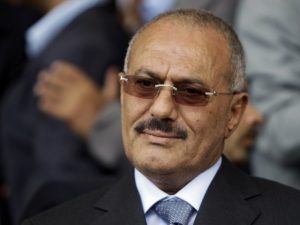






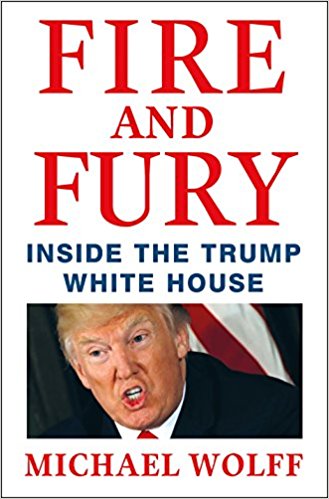
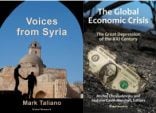 All new members (annual basis) as well as all membership renewal (annual basis) will receive a FREE copy of
All new members (annual basis) as well as all membership renewal (annual basis) will receive a FREE copy of 




